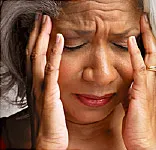Here are the facts about depression in women. In the U.S. about 15 million people experience depression each year. The majority of them are women. Unfortunately, nearly two-thirds do not get the help they need.
Depression in women is very common. In fact, women are twice as likely to develop clinical depression as men. Up to one in four women is likely to have an episode of major depression at some point in life.
What is depression?
 Depression is a serious and pervasive mood disorder. It causes feelings of sadness, hopelessness, helplessness, and worthlessness. Depression can be mild to moderate with symptoms of apathy, little appetite, difficulty sleeping, low self-esteem, and low-grade fatigue. Or it can be more severe.
Depression is a serious and pervasive mood disorder. It causes feelings of sadness, hopelessness, helplessness, and worthlessness. Depression can be mild to moderate with symptoms of apathy, little appetite, difficulty sleeping, low self-esteem, and low-grade fatigue. Or it can be more severe.What are the symptoms of depression in women?
Symptoms of depression in women include:
- persistent sad, anxious, or "empty" mood
- loss of interest or pleasure in activities, including sex
- restlessness, irritability, or excessive crying
- feelings of guilt, worthlessness, helplessness, hopelessness, pessimism
- sleeping too much or too little, early-morning awakening
- appetite and/or weight loss or overeating and weight gain
- decreased energy, fatigue, feeling "slowed down"
- thoughts of death or suicide, or suicide attempts
- difficulty concentrating, remembering, or making decisions
- persistent physical symptoms that do not respond to treatment, such as headaches, digestive disorders, and chronic pain
What are the symptoms of mania in women?
Mania is a highly elevated mood that can occur with bipolar disorder. Moods in bipolar disorder swing from the lows of depression to the highs of mania. Even though mania is an elevated mood, it is serious and needs medical assessment and treatment.
The symptoms of mania include:
- abnormally elevated mood
- irritability
- decreased need for sleep
- grandiose ideas
- greatly increased talking
- racing thoughts
- increased activity, including sexual activity
- markedly increased energy
- poor judgment that can lead to risk-taking behavior
- inappropriate social behavior
Why is depression in women more common than depression in men?
Before adolescence, the rate of depression is about the same in girls and boys. However, with the onset of puberty, a girl's risk of developing depression increases dramatically to twice that of boys.
Experts believe that the increased chance of depression in women may be related to changes in hormone levels that occur throughout a woman's life. These changes are evident during puberty, pregnancy, and menopause as well as after giving birth or experiencing a miscarriage. In addition, the hormone fluctuations that occur with each month's menstrual cycle probably contribute to premenstrual syndrome, or PMS, and premenstrual dysphoric disorder, or PMDD -- a severe syndrome marked especially by depression, anxiety, and mood swings that occurs the week before menstruation and interferes with normal functioning of daily life.
What increases the chances of depression in women?
According to the National Institutes of Health, factors that increase the risk of depression in women include reproductive, genetic, or other biological factors; interpersonal factors; and certain psychological and personality characteristics. In addition, women juggling work with raising kids and women who are single parents suffer more stress that may trigger symptoms of depression. Other factors that could increase risk include:
- family history of mood disorders
- history of mood disorders in early reproductive years
- loss of a parent before age 10
- loss of social support system or the threat of such a loss
- ongoing psychological and social stress, such as loss of a job, relationship stress, separation or divorce
- physical or sexual abuse as a child
- use of certain medications
Women can also get postpartum depression after the birth of a baby. Some people get seasonal affective disorder in the winter. Depression is one part of bipolar disorder.
0 comments:
Post a Comment